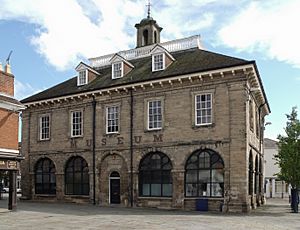Market Hall Museum, Warwick facts for kids
 |
|
| Established | 1836 |
|---|---|
| Location | Warwick, England |
The Market Hall Museum is a historic museum in the town of Warwick, England. It is part of the larger Warwickshire Museum, which is run by a group called Heritage and Culture Warwickshire.
The museum is filled with interesting objects from the local area. You can see things related to archaeology (the study of human history through objects), geology (the study of rocks and the Earth), and natural history.
The Museum's History
A Place for the Market
The Market Hall was built in the late 1600s. It was created to give sellers at the town's market a roof over their heads. The building had big, open arches on the ground floor. This made it easy for people to get to the market stalls. The upstairs rooms were rented out for meetings.
For a short time, a tiny room in the hall was used as a "lock-up" to hold people before they went to trial. The room was very small. A report from 1842 said it was only about 8 feet by 3 feet, and at one point, 13 people were held there at once!
A New Museum is Born
In the 1800s, many people became interested in science and history. In 1836, a group of local men started the Warwickshire Natural History and Archaeological Society. They met in the Market Hall and decided to collect objects related to animals, plants, and minerals.
They put these items on display for the public in the Market Hall. To see the collection, you had to pay one shilling, which was too expensive for many poor families. You could also buy a yearly membership. Members got to attend free talks about history and science.
In 1847, the society held a free event so everyone could see the museum. It was a big success. Over time, the museum's collection grew so large that it needed the entire building. In 1905, the building was updated to be a proper museum. A new front door was added with the word MUSEUM carved in the stone above it.
Becoming a Public Museum
By the early 1900s, the society was running out of money. In 1932, they offered their collection to the Warwickshire County Council (the local government), which accepted. This made Warwickshire the first county in the United Kingdom to have its government directly run a museum.
In 1936, the building was listed as an Ancient Monument, which means it is protected and cannot be knocked down. During the Second World War, it was used to store emergency supplies. After the war, more work was done to the building, and since then, it has been run as a public museum with free entry for everyone.
What Can You See Inside?
Today, the museum displays objects that are important to the history of Warwickshire. Here are some of the amazing things you can find.
- The Warwickshire Bear: Near the entrance, you'll see a large, stuffed bear. It is standing on its back legs, just like the famous Bear and Ragged Staff symbol. This symbol has been linked to the Earls of Warwick for centuries. You can also see it on the logo for Warwickshire County Council and the badge for the Warwickshire County Cricket Club.
- Oisin the Giant Deer: The museum has the complete skeleton of a Giant Irish Deer, which was given to the museum in the 1800s. These huge animals lived long ago and had antlers that could be four meters wide. This skeleton is so popular that the museum's official Twitter account is named after him!
- The Sheldon Tapestry: A tapestry is a large, woven piece of cloth with pictures or designs. The Sheldon Tapestry Map of Warwickshire was made in the 1580s. It's a giant map of the county showing towns, roads, hills, and even drawings of important buildings. It is so big that it takes up an entire wall in the museum.
Visiting the Museum
The Market Hall Museum is free to visit and is open to the public. It is a short walk from Warwick's train and bus stations.
See also

